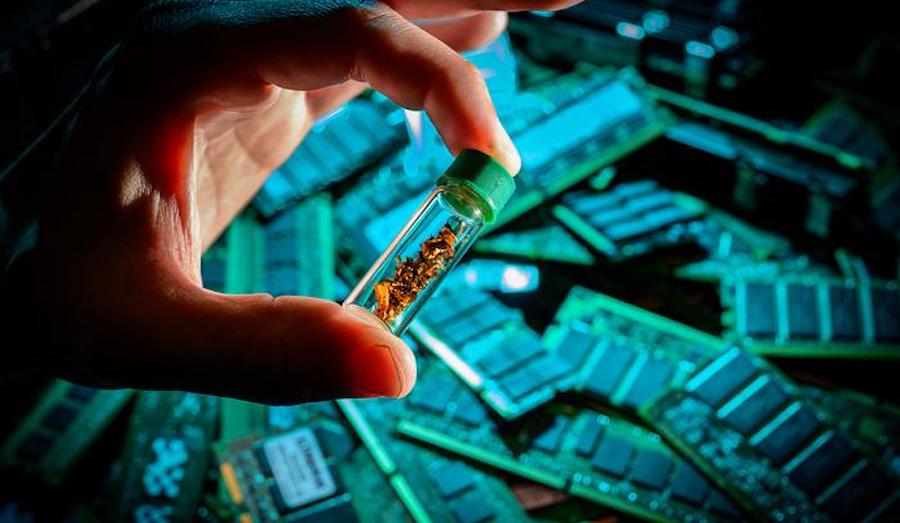A new method to extract gold from e-waste is turning discarded electronics into valuable resources. Scientists from Cornell University and ETH Zurich introduced innovative, sustainable techniques that recover gold without harsh chemicals, signaling a breakthrough in recycling and environmental protection.
Revolutionary Protein Sponge from Whey
Researchers at ETH Zurich crafted an eco-friendly whey protein fibril sponge derived from milk byproducts. This sponge selectively adsorbs gold ions from acid-dissolved circuit boards with high efficiency. In tests, scientists recovered a 450 mg, 22‑carat gold nugget from just 20 motherboards
The process is simple:
- Dissolve gold-bearing circuitry in acid.
- Add the protein sponge.
- Heat to release pure gold flakes.
This method costs 50 × less than the gold recovered, making it both profitable and sustainable
Cornell’s COF Technique Powers CO₂ Conversion
Cornell scientists developed vinyl-linked covalent organic frameworks (VCOFs) that selectively bind gold with 99.9 % purity
Unique to this technique is its dual benefit: once loaded, the gold-laden COFs act as catalysts to convert CO₂ into valuable organic chemicals—creating a closed-loop system that addresses waste and emissions simultaneously
Other Cutting-Edge Techniques on the Horizon
- Graphene-chitosan composite sponges can extract gold with 99.9 % efficiency and be reused multiple times reddit
- Electrochemical liquid-liquid extraction (e-LLE) by the University of Illinois uses energy-efficient, selective extraction columns powered by electrochemistry, achieving significantly lower costs
- Reduced graphene oxide (rGO) membranes from Chinese and UK researchers show ultrahigh gold capture capacities—up to 1,850 mg/g—without additional energy input
Why This Matters
- Environmental benefit: These methods avoid toxic substances like cyanide and reduce energy use.
- Resource efficiency: E-waste contains over 10× more gold than conventional ore, making urban mining a powerful solution
- Economic value: Even at small scales, recovered gold’s worth far exceeds processing costs.
- Innovation leadership: These technologies pave the way for cleaner recycling, CO₂ conversion, and sustainable materials recovery.
What’s Next in E-Waste Gold Recovery
These promising lab innovations now need scaling for industrial use. Key challenges include:
- Scaling production of sponges/COFs
- Ensuring reusability
- Establishing safe, low-energy operations
- Securing patents and investments
ETH Zurich and Cornell teams continue working to commercialize their methods, while graphene and electrochemical processes are entering pilot phases.
Summary Table
| Technique | Highlights |
|---|---|
| Whey protein sponge | 450 mg gold from 20 motherboards; 22‑carat purity |
| VCOF (Cornell) | 99.9% selective; gold catalyzes CO₂ into organics |
| Graphene–chitosan sponge | Reusable; ~99.9% efficiency |
| Electrochemical e-LLE | Low-cost, green, scalable |
| rGO membranes | Ultrahigh capacity, energy-free reduction |
This wave of innovation shows the future of extracting gold from e-waste is sustainable, efficient, and profitable. By transforming waste into wealth—and even reducing CO₂—these methods exemplify a circular economy. Keep an eye on pilot programs and commercialization in the next 6–12 months.



